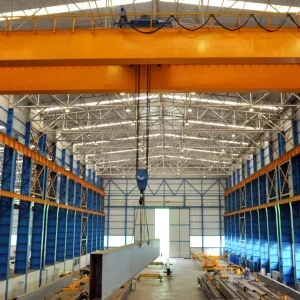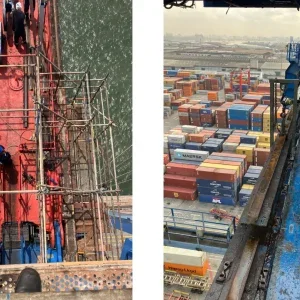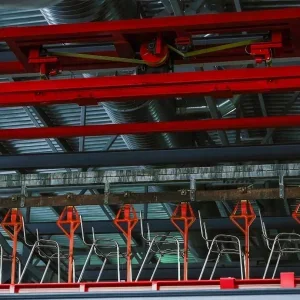It could be a short cut to getting ahead of your competitors, but it simultaneously embodies the risk of a technology dead-end that could leave a pack leader struggling to regain their position.
The advent of RFID technology was no different during WWII, when the technology’s basic principles were first used by the German Luftwaffe to avoid being shot down by their own artillery batteries.
German planes would perform a roll when entering Axis airspace to change the reflected radar image of their planes so that friendly forces knew they were returning. Soon after, allied forces developed the first identify friend or foe (IFF) system to negate their opponents advantage.
RFID technology has long since made its way into commercial territory, with retailers and manufacturers alike using it to optimise their operations.
In the industrial lifting sector, one of the more common uses is as a means to streamline the inspection and certification process of lifting equipment.
Companies like Luton based SiteCert are developing a range of hardware, from ruggedised PDAs to tablet PCs, to provide companies the tools to carry out
quicker inspection and eliminate traditional time-intensive data capture. Indeed SiteCert Director Eoin Ferris claims SiteCert’s proprietary solution can save customers as much as 65% of the typical administration costs associated with inspection and certification.
He says: “On our website we say the cost saving is 40%. It is really more like 65% or 60% but people don’t believe you if you say that!”
Utilised for lifting equipment inspection and certification, SiteCert’s system involves tagging each piece of equipment with a unique passive RFID tag to ensure rapid, accurate identification.
The examiner can then use the reader to wirelessly connect to an online server and see the required parameters and previous inspection records for each item.
Once the equipment has been identified and inspected, the examiner can authorise certification from the handheld RFID reader, which generates a LOLER report online for the customer to download and print.
This is one of the more common uses for RFID in the lifting sector, but part of SiteCert’s business plan shows one reason why the technology is gaining momentum in this, and many other sectors.
SiteCert also runs a partners programme in which they help clients tailor the technology to their specific needs, for instance by tailoring data output to fit the format of the company’s traditional reports structure, and then allow those client companies to resell the technology to those of their customer base who want to carry out in-house inspection.
“Lifting equipment companies can sell this to their customers as well, as this is designed to inspect any type of equipment,” says Ferris.
“Typically our customers have 200 to 300 clients a year [requiring inspection] and they can allow their clients to use SiteCert for their own in-house weekly/before-use inspections and then share the revenue as well.”
Consumer innovation
This kind of partnership between companies developing the technology and the end-users has been highlighted by the director of research operations for technology market research firm VDC Research, Drew Nathanson, as a key reason for RFID’s rapid proliferation.
Nathanson says: “RFID end-users are increasingly focusing on how the technology can and should be
used throughout the enterprise and value chain as opposed to resolving one or two issues within a specific division or group. This desire to extract more value from the RFID solutions has made the end-user community a driving force of innovation. For example, more than half of the RFID suppliers we interviewed last year indicated that their end-users had become ‘partners’ in product development, and that they had been instrumental in extending the technology’s value proposition.”
“The RFID end-user community has changed dramatically over the past few years. It’s moved from a small number of lead adopters to larger groups of what we call early majority, which is considered by most to represent the initial high growth phase of a technology on a technology’s adoption curve.”
Eoin Ferris believes that he has observed this in his dealings with customers and competitors, noting that attitudes to the technology appear to be shifting.
Ferris says: “Last year people were curious and wondering if this PDA inspection would ever take off and we had to explain to everyone what they were and how they worked. This year they realise that if they don’t have a system they are going to be left behind. So the industry is becoming more knowledgeable.”
Of course the use of RFID goes beyond equipment inspection and certification. As reported in the October 2010 issue of Cranes Today, crane rental firm Ainscough has adopted the technology to track and manage the stockpiling and movements of mobile crane components.
After fitting passive RFID tags to different crane components such as mobile crane jibs, when a jib is damaged on a job and needs repair the system allows quick accurate location and identification of a replacement component within the firm’s yard.
The system also provides the facility to ensure that the damaged component in the yard is marked as such on the tag, so if anyone fails to notice the damage and attempts to send the jib out to a job, as soon as the RFID reader reads the tag, the user is notified of the damage and the crane component’s repair schedule.
Looking deeper
Although initially adopting the RFID system to track mobile crane jibs, Ainscough intend to expand use of RFID to track every vital component on each crane.
Ainscough’s choice of RFID provider, Core RFID, used their proprietary CheckedOK system to implement the technology into the firm’s inventory system in such a widespread manner.
Core RFID marketing manager John Williams notes that as the technology has become better developed and cheaper to integrate, companies are beginning to integrate RFID more deeply into the operations to dramatically maximise efficiencies and enhance core processes.
Williams says: “We’re certainly handling more enquiries than we have been previously. What we do find is that there is always quite a time lag between people starting to think about it, showing interest, and then actually getting on and doing something.
“I think it’s partly the growth in expertise. Because people have now done pilots the marketplace is better able to do things. The other thing that has happened with the advent of UHF technology is as the usage of UHF has gone up, the price of tags and the readers has gone down, so it makes it more cost-effective.
“You’ve also got much better levels of standardisation in terms of tags and readers and how they would treat it in Europe, the US and the Far East. Once you start to get those sorts of standards, people feel a bit more comfortable about it and it becomes a bit more practical for people.”
Nathanson seems to agree, noting: “Rapid integration and lower costs have improved the return on investment (ROI) models, but the broader use is what’s really had the greatest impact over the past few years. As with any Automatic Identification and Data Capture (AIDC) solution, the more pervasive the technology is throughout the value chain, the greater the benefit.
“So as RFID continues to percolate through the enterprise and value chain, the business models will become increasingly more attractive and easier to justify.”
Nathanson cites a survey undertaken by VDC Research in the fourth quarter of last year that showed the average improvement in a company’s performance that could be attributed to RFID implementation was approximately 30%, in some cases rising above 40%.
Pioneering risk
With the prevalence of pilot projects providing benchmark data to allow easier formulation of a business case for RFID adoption, Nathanson believes that RFID is rapidly approaching the critical mass stage of its technology adoption curve that will render RFID an essential part of many business operations.
When pioneers of any given technological innovation have had their ranks bolstered by the early adopters of the technology, progress towards this stage continues apace. And once it is reached the companies involved from the outset often make the greatest gains.
However, for a technology rather simple in it’s method of operation, it’s integration has to carefully managed to ensure that the benefits expected are realistic in situ.
Three years ago, a manufacturer and distributor of steel coils approached automated inventory control solutions firm SPEDE (Standard Platform for Electronic Data Entry) Technologies about an RFID pilot project.
The coil manufacturer wanted to automate the coil picking process using a bridge crane fitted with RFID sensors along the bridge. The crane could also record the position of stored coils using x,y,z positioning.
The firm’s intention was to have the crane identify the correct coil, which would have an RFID tag on it’s packaging, before handling the coil.
However, in a warehouse environment featuring thousands of metal coils stacked several feet high, the interference in the radio frequency signal caused by the abundance of metal in the environment rendered accurate identification impossible.
SPEDE technologies’ Bob Bunsey explained: “If you have a coil bay that has different size coils, stacked at different heights you are going to get reflections. Certain things can be done to minimise any issues, but you will not get 100% certainty.”
While metal is known to interfere with the accuracy of a read when using Ultra-High Frequency (UHF) RFID, the level dependent on the distance the RFID reader is from the tag, the technology can be tailored with higher signal strengths, the use of High Frequency (HF) tags and shorter read distances.
But this was not acceptable for the client. Bunsey offered the firm different solutions to the problem, including lifting a picked coil above the field of interference and providing a portable reader for the
crane operator to use when interference was an issue, but to no avail.
Bunsey said: “I think it could work if you have the latitude to bring the coil to the cab, but the customer expected 100% read accuracy in an environment where you had stacks of coils, and they wanted to be able to read the tags without lifting above level of the stacks to avoid ‘reflections’ from other metal objects.
“We weren’t able to do it in that environment. It’s very possible with improved RFID readers to adjust the signal strength to limit the spurious reads, but you would need the signal strength changes to be occurring in real-time.”
So there are limitations to the technology but these are becoming better understood, and as technology innovations continue to increase in frequency companies are better placed to understand how to effect better implementation.
And with the technology now very much proven, Nathanson concludes that 2012 will see the technology achieve the critical mass that sparks widespread adoption.






